Cloudy glasses are due to either hard water deposits or etching from harsh dish detergents. Most home remedies on the internet are totally ineffective. Learn from a glass professional how to remove cloudiness from glass or crystal.
The best way to clean cloudy glasses is either to use a professional hard-water stain remover like Water Spot Remover from CRL or to polish with cerium oxide. Most other, highly promoted, substances like toothpaste, household vinegar, lemon juice, eggshells, baking soda, borax, acetone, WD-40, CLR, and others are ineffective.
The first step is to determine the cause of the cloudiness – is it hard water or etching by detergents?

Impatient for the answer?
Jump to our foolproof system for analyzing and cleaning cloudy glasses.
Artistry in Glass is an Amazon Associate – we earn a commission from qualifying purchases.
Before revealing the answer to all your cloudy glass questions, it is interesting to discuss the bewildering array of ideas for removing cloudiness in glassware and crystal found on the internet. These ideas can be divided into dissolving methods and abrasive methods.
Dissolving methods
There is scientific justification for some of these liquids because hard water stains are mostly composed of carbonates (calcium & magnesium) that are dissolved by acids like vinegar (acetic acid) and lemon juice (citric acid).
- Vinegar
- Lemon juice
- Ammonia
- Rubbing Alcohol
- Hydrogen peroxide
- WD-40
- Commercial products like CLR (Calcium/Lime/Rust)
- Nail polish remover (acetone)
Some ideas make sense in theory but ……
Note that vinegar may be effective on minor hard water stains because acetic acid dissolves calcium carbonate. The problem is that household vinegar is only 5% acetic acid and is not strong enough for tough stains. If you would rather use vinegar instead of our #1 recommendation, then purchase the industrial strength variety (75% acetic acid) from Amazon. (Don’t forget to follow the safety instructions).
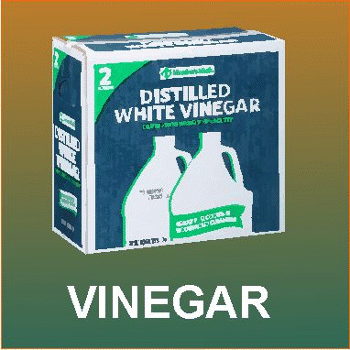
Note that liquids other than acids have no chance of dissolving hard water deposits. So do not waste your time with acetone, alcohol, hydrogen peroxide, or ammonia – read on to find the guaranteed and proven methods.
Abrasive methods (grinding/polishing)
The idea behind the second category of home remedies is to use mechanical methods to remove the cloudiness. Either by removing a very small surface layer (by polishing) or by bombarding the surface with hard objects (rice/lead shot) to loosen up and dislodge the cloudy scale.
- Baking soda (sodium bicarbonate) – pH 8.0 – hardness 2
- Cream of tartar (tartaric acid) pH 3.00
- Borax (sodium tetraborate) – pH 9.5 hardness 2 – 2.5
- Fluoride toothpaste (with calcium carbonate – hardness 3)
- Denture tablets (effervescent)
- Any of the above solvents like vinegar together with:
- Uncooked rice, peas, eggshells, lead shot.
- Fine sandpaper (5000 to 10,000 grit) or steel wool
- 3-m “Scotch-Brite” pads
- Mr Clean “Magic Eraser”
Some methods make sense in theory but ……
Like everything else in life, there is some truth in even the most bizarre conspiracy theories. However, most of these abrasives (like the minerals in toothpaste) or the grains of baking soda are much too soft to be effective.
Also, used by amateurs, many abrasive methods can make the situation worse by scratching (especially easy to do with soft lead crystal).
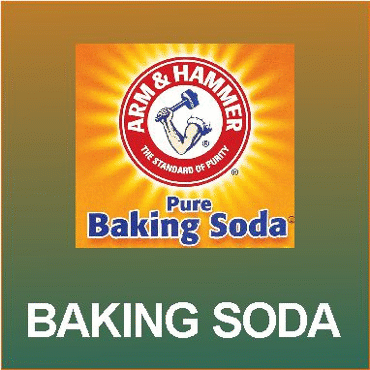
Ineffective abrasive methods purported to remove cloudiness – using products commonly available in the home. Note that some products, used in conjunction with solvents, (like crushed eggshells or dried rice swished around with vinegar) may be effective on minor hazing.
The truth about home glass cleaning remedies!
Traditionalists really love old-fashioned home remedies because they appeal to their frugal instincts and because they use products that are commonly available in the home (either under the kitchen sink or in the bathroom).
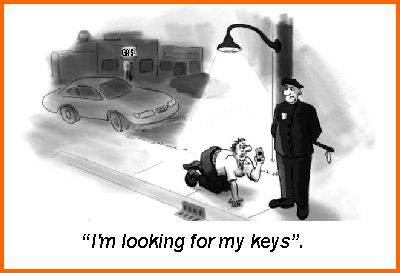
Using the wrong products, because they are available, is like searching for your keys in the wrong place (because light is available).
The unfortunate fact is that most do not work except on very minor hazing, many are a complete waste of time, some are counter-productive, and a few will cause damage.
The common frustration, as you try these methods, is that the glass appears to be miraculously restored to its original sparkle – only for the dreaded cloudiness to reappear as the moisture gradually evaporates.
If you would rather watch the post on YouTube – click the video below:
Step 1: Identify the cloudiness
The first, and most crucial step in cleaning glasses is to find out what’s causing the cloudiness.
Two main types of cloudiness affect crystal and glassware: hard water deposits and haziness caused by the etching of crystal with strong detergents. It is vital to distinguish between them in order to choose the best treatment.
Cloudiness caused by hard water deposits:
Most domestic water supplies contained dissolved mineral salts unless you have a well-calibrated water-softening system.
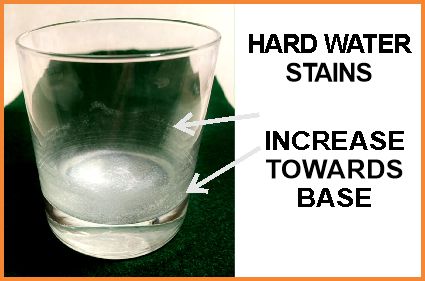
Hard water stains are whitish surface deposits of calcium carbonate and other salts caused by the evaporation of tap water. The staining often shows a pattern of rings marking the decreasing levels of the evaporating water.
How to remove hard water stains
Don’t waste time with home remedies – use professional water spot remover from CRL for quick and easy removal of hard water deposits
Making sure to use rubber gloves and protective face wear, carefully pour CRL Water Spot Remover into the glass, vase, or bowl that has hard water stains. (For most stains you can use a 50-50 dilution with tap water, but increase to full strength for serious deposits.)
Stir or agitate the liquid with a soft brush and observe the hard water scale miraculously fall away from the surface of the glass. Do not allow the CRL liquid to sit in the crystal – you may form a ring – pour it out of the glass once you see that it has worked and immediately rinse thoroughly with clean water. (save the used CRL – it is strong and can be used several times).
!!CAUTION!! (the small print)
CRL WATER SPOT REMOVER IS VERY DANGEROUS. FOLLOW THE MANUFACTURER’S INSTRUCTIONS. ARTISTRY in GLASS CAN NOT BE RESPONSIBLE FOR ACCIDENTS OR INJURIES INCURRED AS A RESULT OF USING CRL WATER SPOT REMOVER
Precautions before using CRL
Never use CRL on decorated (enameled, painted, or gilded) glass or crystal without careful testing. Always test CRL on a Q-tip on an inconspicuous part of the crystal (the base) before using.
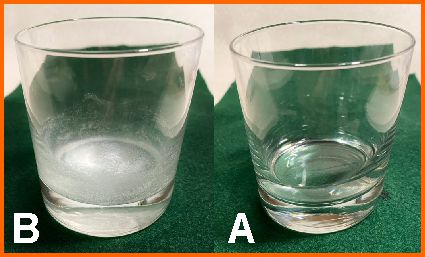
Before and after views of glass treated with CRL Water Spot Remover. If the cloudiness does not disappear then your crystal must have suffered from etching (see below).
Hard water stains are removed from vase
Here is a case study of an antique green vase from a yard sale that had extremely ugly hard water stains.
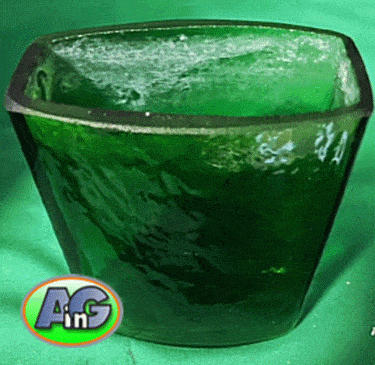
The customer had tried all the usual folk remedies including vinegar, bleach and you name it but the experts at Artistry in Glass quickly solved (dissolved) the problem with the magic of CRL water spot remover – available from Amazon!
Hard water stains in Lalique crystal vase
Lalique crystal vases are known for their exquisite beauty and timeless elegance. These vases are made by the French luxury brand Lalique, which was founded in 1888 by René Lalique.
Each Lalique crystal vase is a work of art, featuring intricate designs and patterns that are inspired by nature and the Art Deco movement. The vases are made using a variety of techniques, including hand-carving and acid etching.
This valuable vase (below) was brought into Artistry in Glass with very serious hard water staining.
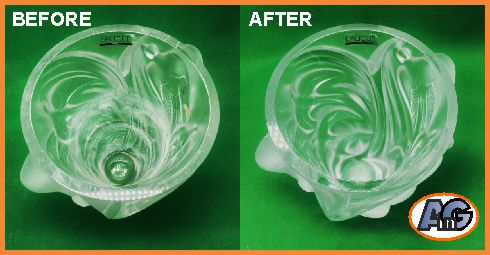
The amazing CRL water spot remover performs its magic again – we fill the vase to the top, agitate for 5 minutes then drain (putting the CRL liquid back into the bottle for reuse).
Haziness caused by etching of crystal
A quite different type of cloudiness is caused by strong detergents or phosphates attacking the surface of the crystal. Etching of this type is not a surface deposit but is a change to the atomic structure and it is most common in delicate lead crystal like Waterford, Lalique, Bacarrat, and Swarovski. Jump to this section for tips on the washing and care of fine crystal.
Case study – cloudy lead crystal with scratches
When interviewed, the customer revealed that she had regularly washed these glasses in the dishwasher. On examination, the hazy cloudiness looked like the product of etching by the phosphates or strong chemicals in dishwasher detergents.
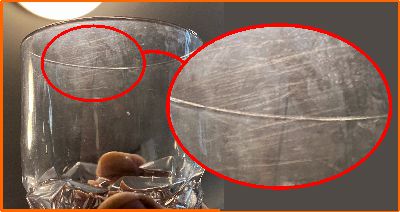
Swarovski crystal whiskey glass with hazing. The owner tried to remove the cloudiness but used an abrasive 3M Scotch-Brite scouring pad and made the glass worse by creating very fine scratches.
The correct approach to remove fine scratches and dishwasher stains
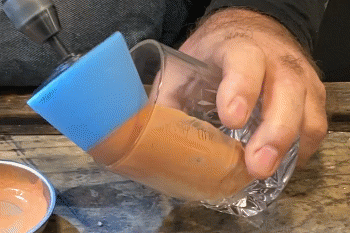
A simple, effective, and foolproof method of removing haze and fine scratches is to polish with cerium oxide on a foam pad. Cerium oxide is a fine abrasive specially formulated for glass.
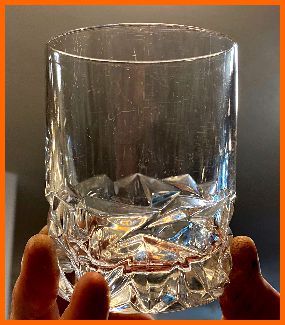
Clouding is removed and the lead crystal sparkles like new. Note that cerium oxide will remove fine scratches but not ones deep enough to be felt with a fingernail.
Recommended foam pads & cerium oxide
Our favorite products for polishing cloudy glass are those shown below (available on Amazon). There is a wide variety of pads so use your common sense to choose large or smaller ones depending on whether you are fixing small shot glasses or large vases.
Notes on the dangers of lead crystal
Because of the dangers of poisoning, lead is not used in the manufacture of fine crystal these days. For a full explanation of the properties of lead crystal and the dangers to pregnant women – be sure to check out this extremely informative post.
Tips for the washing and care of stemware
- Remove rings & jewelry before washing crystal
- Wash stemware in warm soapy water – never in the dishwasher
- Place a washcloth in the bottom of the sink
- Hold crystal by the bowl – never the stem
- Before using, make sure the glass is free from detergent
- Never pour very hot liquid into crystal
- Check for water spots before storing your crystal
- Remove water spots with a mixture of vinegar & water
- Do not store crystal stemware resting on its rim
- Never store one crystal glass inside another one
Glass tabletops & shelves – info from Artistry in Glass
- Benefits of glass shelving – info from experts!
- How much do glass tabletops cost?
- Do glass shelves need to be tempered?
- What is the best thickness for glass shelves?
- Best edge type for glass shelves, polished or beveled?
- How much weight can a wall shelf carry?
- What color glass should my shelves be?
- Glass tabletops – 10 amazing benefits explained
- How to order a glass tabletop
- Best thickness for glass tabletops – expert advice
- Should glass tabletops be tempered?
- Should glass tabletops be beveled?
- How to paint a glass tabletop
- All about tempering glass tabletops!
- How to tell if your glass is tempered
- Can tempered glass be cut?
- How to protect your wood table with glass
- How to fix a scratched glass tabletop
- How to fix a chipped glass tabletop
- How to replace broken patio table glass
- How to measure for a glass tabletop
- Video – how to measure your tabletop
- Plexiglass vs glass – pros and cons
- Beveled glass table base – a case study
- Choosing between tempered & laminated glass
- Glossary of terms used in the glass business
Artistry in Glass: your source for antique repair in Tucson
Check out these informative articles:-
- Where can I get antiques repaired?
- Are broken antiques worth fixing?
- How to fix a broken picture frame
- How to repair a broken china plate
- How to repair a broken china teapot
- How to fix a broken marble slab
- How to repair a broken china coffee mug
- How to repair a 2000-year-old sculpture
- All about repairing stained-glass lampshades
- How to care for your stained glass skylight
- How to repair Dalle de Verre
- Is stained glass worth repairing?
- To repair or toss out?
- What to do with broken antiques
- Is lead crystal dangerous?
- Repairing an antique Mexican statue
- Repairing religious statues
- The history of Swarovski crystal figurines
- How to find the value of a Swarovski Crystal figurine
- Have Swarovski figurines lost value since 2009?
- How to collect Swarovski annual ornaments
- How to display Swarovski crystal figurines
- How to authenticate a Swarovski crystal figurine
- How to display Swarovski annual ornaments
- How to clean Swarovski crystal figurines
- How to repair a Swarovski crystal mouse
- How to repair a Swarovski annual ornament
- How to repair a Swarovski crystal train set
- Fixing broken wine glass stems
- How to clean cloudy glasses
- Why do wine glasses have stems?
- Swarovski Crystal Figurines
- How to repair a chip in a wine glass
- How to fix a scratched glass tabletop
- How to replace a broken patio tabletop






